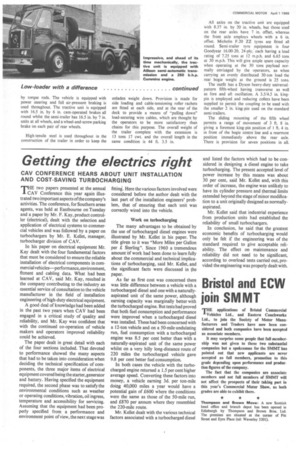Getting the electrics right
Page 42

If you've noticed an error in this article please click here to report it so we can fix it.
CAV CONFERENCE HEARS ABOUT UNIT INSTALLATION AND COST-SAVING TURBOCHARGING TICIE two papers presented at the annual AV Conference this year again illustrated two important aspects of the company's activities. The conference, for Southern areas agents, was held at Eastbourne on Tuesday and a paper by Mr. F. Kay, product controller (electrical), dealt with the selection and application of electrical systems to commercial vehicles and was followed by a paper on turbochargers by Mr. E. Kellet, manager, turbocharger division of CAV.
In his paper on electrical equipment Mr. Kay dealt with the four fundamental factors that must be considered to ensure the reliable installation of electrical components in commercial vehicles—performance, environment, fitment and cabling data. What had been learned at CAV, said Mr. Kay, resulted in the company contributing to the industry an essential service of consultation to the vehicle manufacturer in the field of installation engineering of high-duty electrical equipment.
A good deal of knowledge had been added in the past two years when CAV had been engaged in a critical study of quality and reliability, and Mr. Kay was confident that with the continued co-operation of vehicle makers and operators improved reliability could be achieved.
The paper dealt in great detail with each of the four sections included. That devoted to performance showed the many aspects that had to be taken into consideration when deciding the technical specification of components, the three major items of electrical equipment covered being the starter, generator and battery. Having specified the equipment required, the second phase was to satisfy the environmental conditions such as weather or operating conditions, vibration, oil ingress, temperature and accessibility for servicing. Assuming that the equipment had been properly specified from a performance and environment point of view, the next stage was fitting. Here the various factors involved were considered before the author dealt with the last part of the installation engineers' problem, that of ensuring that each unit was correctly wired into the vehicle.
Work on turbocharging The many advantages to be obtained by the use of turbocharged diesel engines were illustrated by Mr. Kellet in his paper. The title given to it was "More Miles per Gallon per £ Sterling". Since 1960 a tremendous amount of work had been done to learn fully about the commercial and technical implications of turbocharging, said Mr. Kellet, and the significant facts were discussed in the paper.
As far as first cost was concerned there was little difference between a vehicle with a turbocharged diesel and one with a naturallyaspirated unit of the same power, although earning caPacity was marginally better with the turbocharged engine. But tests had proved that both fuel consumption and performance were improved when a turbocharged diesel was installed. These had been concerned with a 12-ton vehicle and on a 50-mile undulating run, fuel consumption with a turbocharged engine was 8.5 per cent better than with a naturally-aspirated unit of the same power whilst on a very hilly long-distance route of 220 miles the turbocharged vehicle gave 9.8 per cent better fuel consumption.
In both cases the vehicle with the turbocharged engine returned a 1.5 per cent higher average speed. Converting these factors into money, a vehicle earning 3d. per ton-mile doing 40,000 miles a year would have a potential gain of £600 where the conditions were the same as those of the 50-mile run, and £870 per annum where they resembled the 220-mile route.
Mr. Kellet dealt with the various technical factors associated with a turbocharged diesel and listed the factors which had to be considered in designing a diesel engine to take turbocharging. The present accepted level of power increase by this means was about 30 per cent, said Mr. Kellet and, with this order of increase, the engine was unlikely to have its cylinder pressure and thermallimits extended beyond the stage of minor modification to a unit originally designed as normallyaspirated.
Mr. Kellet said that industrial experience from production units had established the reliability of small turbochargers.
In conclusion, he said that the greatest economic benefits of turbocharging would only be felt if the engineering was of the standard required to give acceptable reliability. The effect on maintenance and reliability did not need to be significant, according to overload tests carried out, provided the engineering was properly dealt with.




















































































































